Synthesis of Semicrystalline Long Chain Aliphatic Polyesters by ADMET Copolymerization of Dianhydro-D-glucityl bis(undec-10-enoate) with 1,9-Decadiene and Tandem Hydrogenation
Abstract
:1. Introduction
2. Results and Discussion
2.1. One Pot Synthesis of Long Chain Polyesters by ADMET Copolymerization of Dianhydro-D-Glucityl bis(undec-10-enoate) (M1) with 1,9-Decadiene (DCD) and Tandem Hydrogenation
2.2. ADMET Copolymerization of M1 with 1,13-Tetradecadiene (TDCD) and Tandem Hydrogenation
3. Concluding Remarks
4. Materials and Methods
Author Contributions
Funding
Conflicts of Interest
References
- Gandini, A. Polymers from renewable resources: A challenge for the future of macromolecular materials. Macromolecules 2008, 41, 9491–9504. [Google Scholar] [CrossRef]
- Coates, G.W.; Hillmyer, M.A. A virtual issue of Macromolecules: Polymers from renewable resources. Macromolecules 2009, 42, 7987–7989. [Google Scholar] [CrossRef] [Green Version]
- Mülhaupt, R. Green polymer chemistry and bio-based plastics: Dreams and reality. Macromol. Chem. Phys. 2013, 214, 159–174. [Google Scholar] [CrossRef]
- Gandini, A.; Lacerda, T.M. (Eds.) Monomers and polymers from chemically modified plant oils and their fatty acids. In Polymers from Plant Oils, 2nd ed.; John Wiley & Sons, Inc.: Hoboken, NJ, USA; Scrivener Publishing LLC: Beverly, MA, USA, 2019; pp. 33–82. [Google Scholar]
- Yao, K.; Tang, C. Controlled polymerization of next-generation renewable monomers and beyond. Macromolecules 2013, 46, 1689–1712. [Google Scholar] [CrossRef]
- Wang, Z.; Yuan, L.; Tang, C. Sustainable elastomers from renewable biomass. Acc. Chem. Res. 2017, 50, 1762–1773. [Google Scholar] [CrossRef]
- Nomura, K.; Awang, N.W.B. Synthesis of bio-based aliphatic polyesters from plant oils by efficient molecular catalysis: A selected survey from recent reports. ACS Sustain. Chem. Eng. 2021, 9, 5486–5505. [Google Scholar] [CrossRef]
- Coulembier, O.; Degée, P.; Hedrick, J.L.; Dubois, P. From controlled ring-opening polymerization to biodegradable aliphatic polyester: Especially poly (β-malic acid) derivatives. Prog. Polym. Sci. 2006, 31, 723–747. [Google Scholar] [CrossRef]
- Meier, M.A.R.; Metzger, J.O.; Schubert, U.S. Plant oil renewable resources as green alternatives in polymer science. Chem. Soc. Rev. 2007, 36, 1788–1802. [Google Scholar] [CrossRef]
- Biermann, U.; Bornscheuer, U.; Meier, M.A.R.; Metzger, J.O.; Schäfer, H.J. Oils and fats as renewable raw materials in chemistry. Angew. Chem. Int. Ed. 2011, 50, 3854–3871. [Google Scholar] [CrossRef]
- Stempfle, F.; Ortmann, P.; Mecking, S. Long-chain aliphatic polymers to bridge the gap between semicrystalline polyolefins and traditional polycondensates. Chem. Rev. 2016, 116, 4597–4641. [Google Scholar] [CrossRef] [PubMed] [Green Version]
- Hillmyer, M.A.; Tolman, W.B. Aliphatic polyester block polymers: Renewable, degradable, and sustainable. Acc. Chem. Res. 2014, 47, 2390–2396. [Google Scholar] [CrossRef] [PubMed]
- Schwendeman, J.E.; Church, A.C.; Wagener, K.B. Synthesis and catalyst issues associated with ADMET polymerization. Adv. Synth. Catal. 2002, 344, 597–613. [Google Scholar] [CrossRef]
- Mutlu, H.; de Espinosa, L.M.; Meier, M.A.R. Acyclic diene metathesis: A versatile tool for the construction of defined polymer architectures. Chem. Soc. Rev. 2011, 40, 1404–1445. [Google Scholar] [CrossRef]
- Schulz, M.D.; Wagener, K.B. Precision polymers through ADMET polymerization. Macromol. Chem. Phys. 2014, 215, 1936–1945. [Google Scholar] [CrossRef]
- Chen, Y.; Abdellatif, M.M.; Nomura, K. Olefin metathesis polymerization: Some recent developments in the precise polymerizations for synthesis of advanced materials (by ROMP, ADMET). Tetrahedron 2018, 74, 619–692. [Google Scholar] [CrossRef]
- Rybak, A.; Meier, M.A.R. Acyclic diene metathesis with a monomer from renewable resources: Control of molecular weight and one-step preparation of block copolymers. ChemSusChem 2008, 1, 542–547. [Google Scholar] [CrossRef] [PubMed]
- Fokou, P.A.; Meier, M.A.R. Use of a renewable and degradable monomer to study the temperature-dependent olefin isomerization during ADMET polymerizations. J. Am. Chem. Soc. 2009, 131, 1664–1665. [Google Scholar] [CrossRef] [PubMed]
- De Espinosa, L.M.; Ronda, J.C.; Galià, M.; Cádiz, V.; Meier, M.A.R. Fatty acid derived phosphorus-containing polyesters via acyclic diene metathesis polymerization. J. Polym. Sci. Part A Polym. Chem. 2009, 47, 5760–5771. [Google Scholar] [CrossRef]
- Ortmann, P.; Mecking, S. Long-spaced aliphatic polyesters. Macromolecules 2013, 46, 7213–7218. [Google Scholar] [CrossRef]
- Lebarbé, T.; Neqal, M.; Grau, E.; Alfos, C.; Cramail, H. Branched polyethylene mimicry by metathesis copolymerization of fatty acid-based α,ω-dienes. Green Chem. 2014, 16, 1755–1758. [Google Scholar] [CrossRef] [Green Version]
- Shearouse, W.C.; Lillie, L.M.; Reineke, T.M.; Tolman, W.B. Sustainable polyesters derived from glucose and castor oil: Building block structure impacts properties. ACS Macro Lett. 2015, 4, 284–288. [Google Scholar] [CrossRef]
- Llevot, A.; Grau, E.; Carlotti, S.; Greliera, S.; Cramail, H. ADMET polymerization of bio-based biphenyl compounds. Polym. Chem. 2015, 6, 7693–7700. [Google Scholar] [CrossRef] [Green Version]
- Barbara, I.; Flourat, A.L.; Allais, F. Renewable polymers derived from ferulic acid and biobased diols via ADMET. Eur. Polym. J. 2015, 62, 236–243. [Google Scholar] [CrossRef] [Green Version]
- Dannecker, P.K.; Biermann, U.; Sink, A.; Bloesser, F.R.; Metzger, J.O.; Meier, M.A. Fatty acid-derived aliphatic long chain polyethers by a combination of catalytic ester reduction and ADMET or thiol-ene polymerization. Macromol. Chem. Phys. 2019, 220, 1800400. [Google Scholar] [CrossRef]
- Le, D.; Samart, C.; Kongparakul, S.; Nomura, K. Synthesis of new polyesters by acyclic diene metathesis polymerization of bio-based α,ω-dienes prepared from eugenol and castor oil (undecenoate). RSC Adv. 2019, 9, 10245–10252. [Google Scholar] [CrossRef] [Green Version]
- Moser, B.R.; Vermillion, K.E.; Banks, B.N.; Doll, K.M. Renewable aliphatic polyesters from fatty dienes by acyclic diene metathesis polycondensation. J. Am. Oil Chem. Soc. 2020, 97, 517–530. [Google Scholar] [CrossRef]
- Nomura, K.; Chaijaroen, P.; Abdellatif, M.M. Synthesis of bio-based long chain polyesters by acyclic diene metathesis (ADMET) polymerization and tandem hydrogenation, and depolymerization with ethylene. ACS Omega 2020, 5, 18301–18312. [Google Scholar] [CrossRef]
- Inci, B.; Lieberwirth, I.; Steffen, W.; Mezger, M.; Graf, R.; Landfester, K.; Wagener, K.B. Decreasing the alkyl branch frequency in precision polyethylene: Effect of alkyl branch size on nanoscale morphology. Macromolecules 2012, 45, 3367–3376. [Google Scholar] [CrossRef]
- Baughman, T.W.; Chan, C.D.; Winey, K.I.; Wagener, K.B. Synthesis and morphology of well-defined poly(ethylene-co-acrylic acid) copolymers. Macromolecules 2007, 40, 6564–6571. [Google Scholar] [CrossRef]
- Sworen, J.C.; Smith, J.A.; Berg, J.M.; Wagener, K.B. Modeling branched polyethylene: Copolymers possessing precisely placed ethyl branches. J. Am. Chem. Soc. 2004, 126, 11238–11246. [Google Scholar] [CrossRef] [PubMed]
- Li, H.; Rojas, G.; Wagener, K.B. Precision long-chain branched polyethylene via acyclic diene metathesis polymerization. ACS Macro Lett. 2015, 4, 1225–1228. [Google Scholar] [CrossRef]
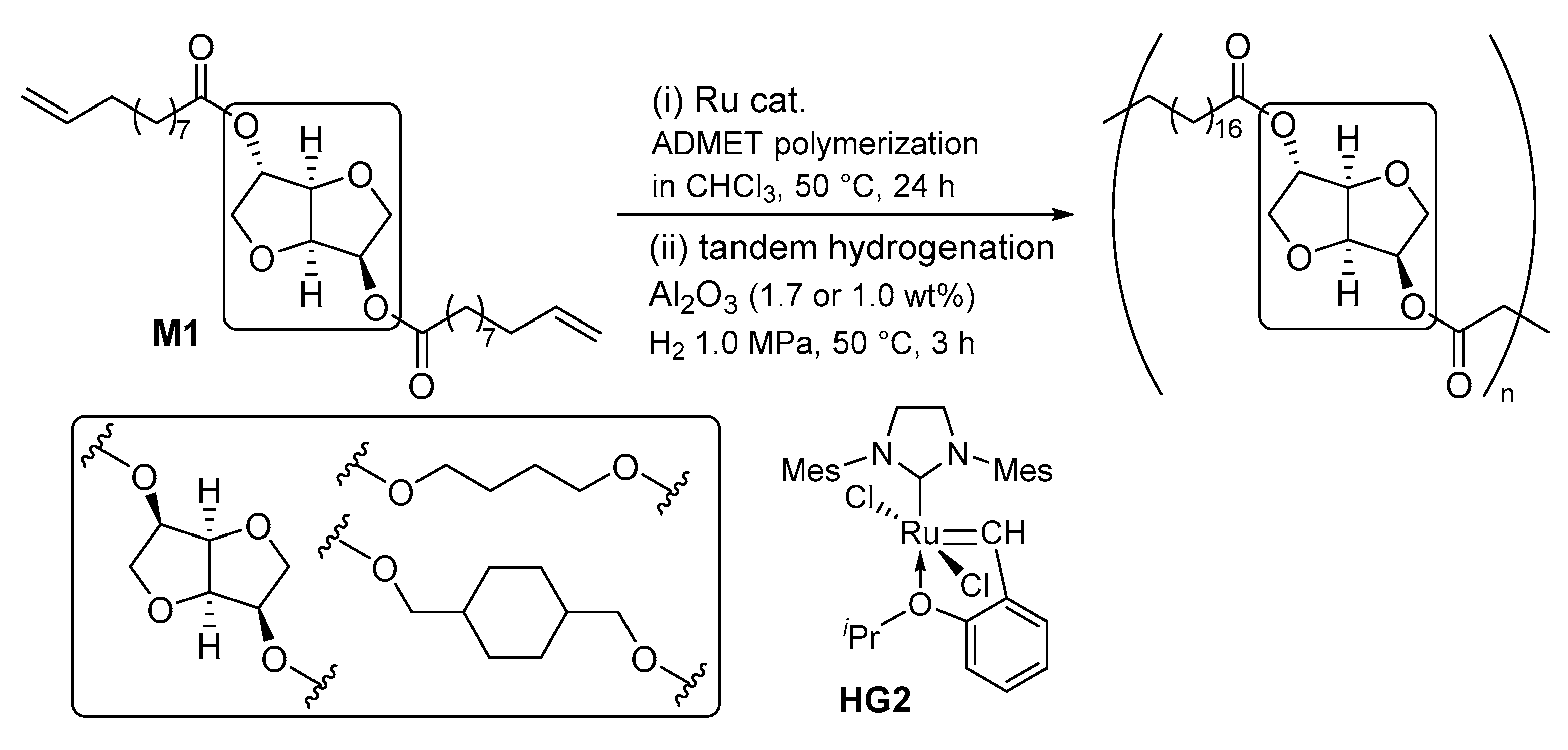
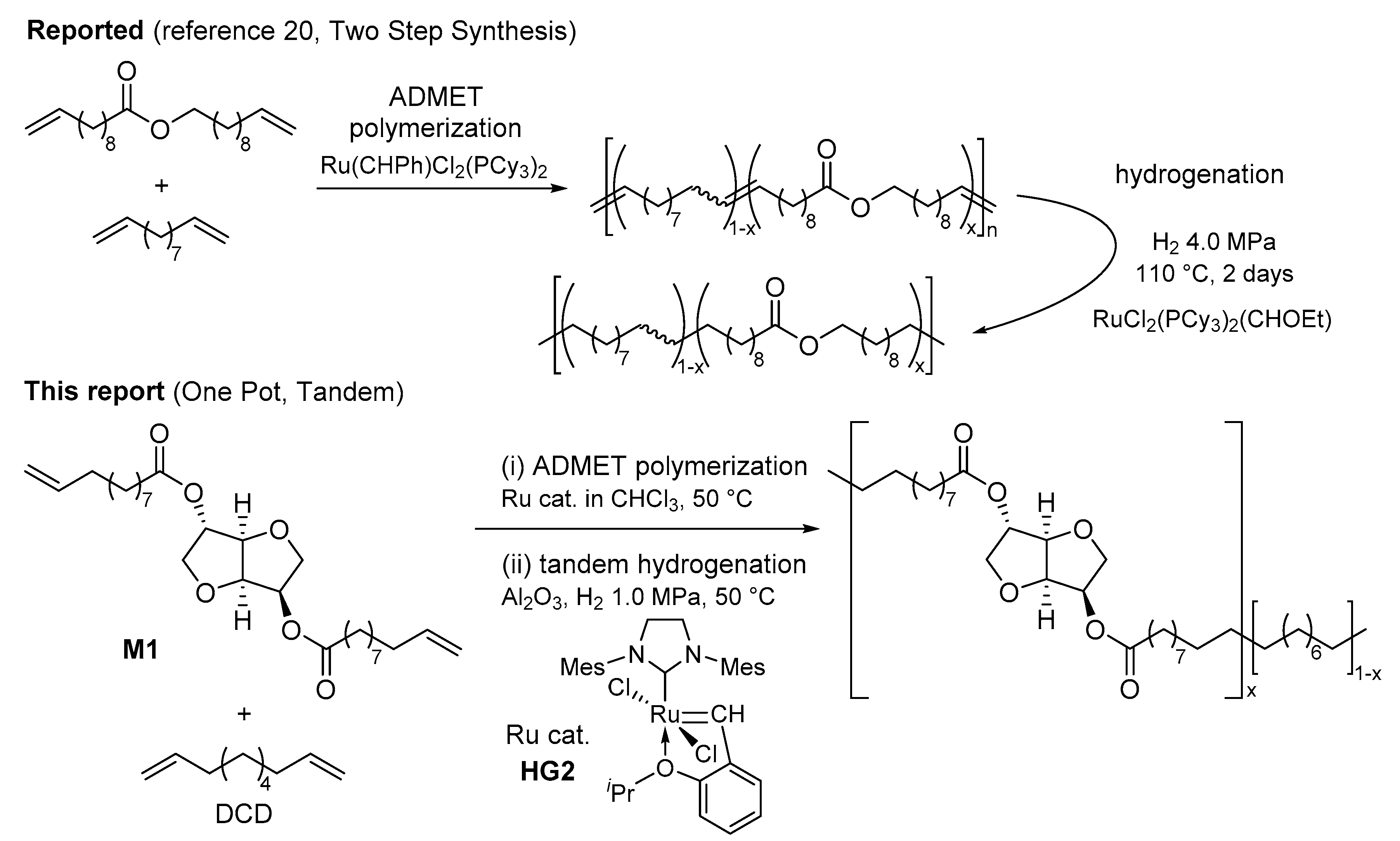
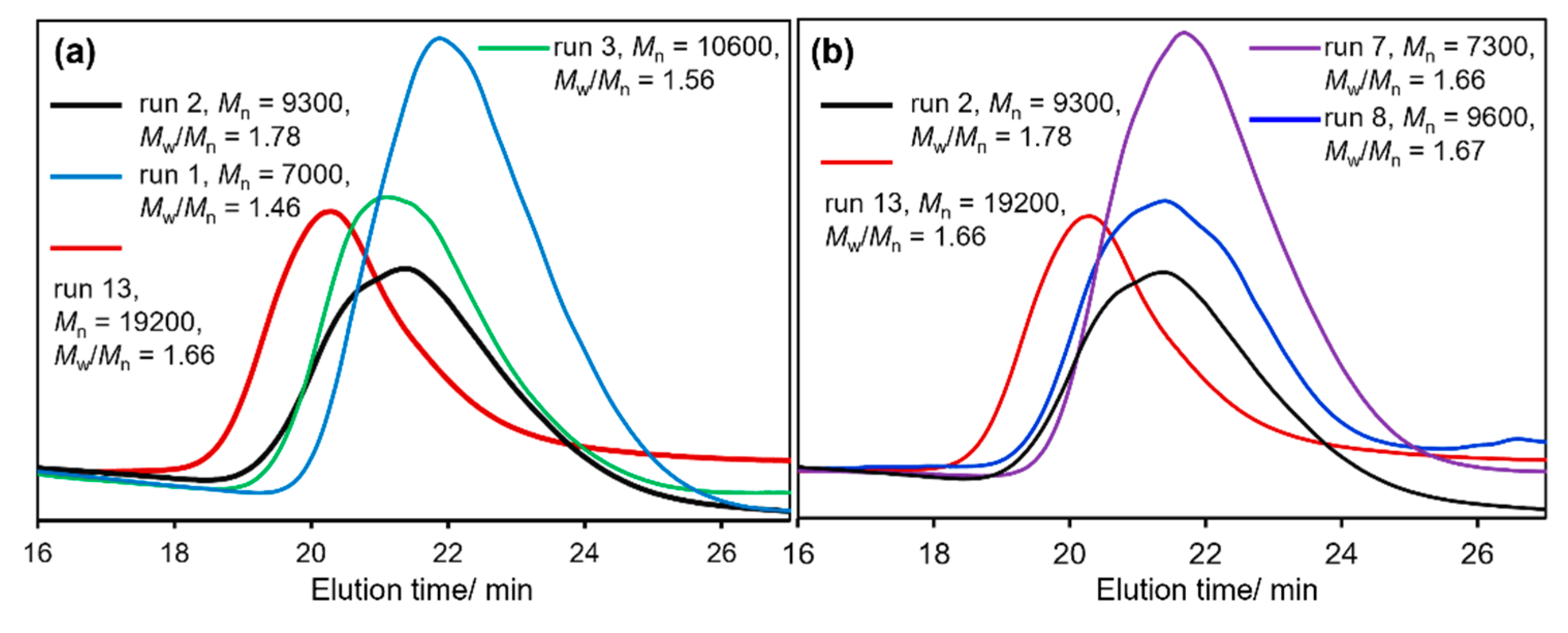
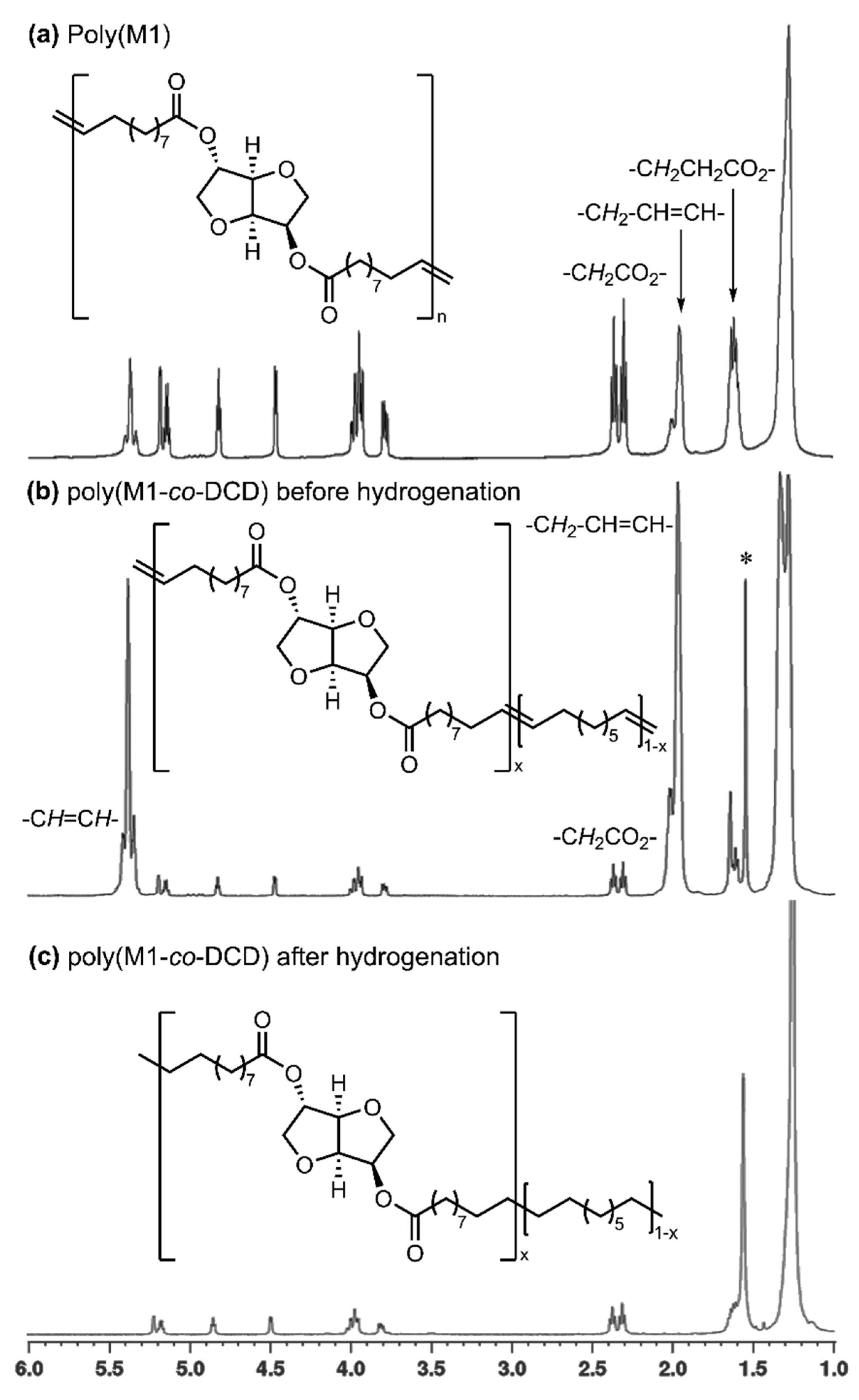

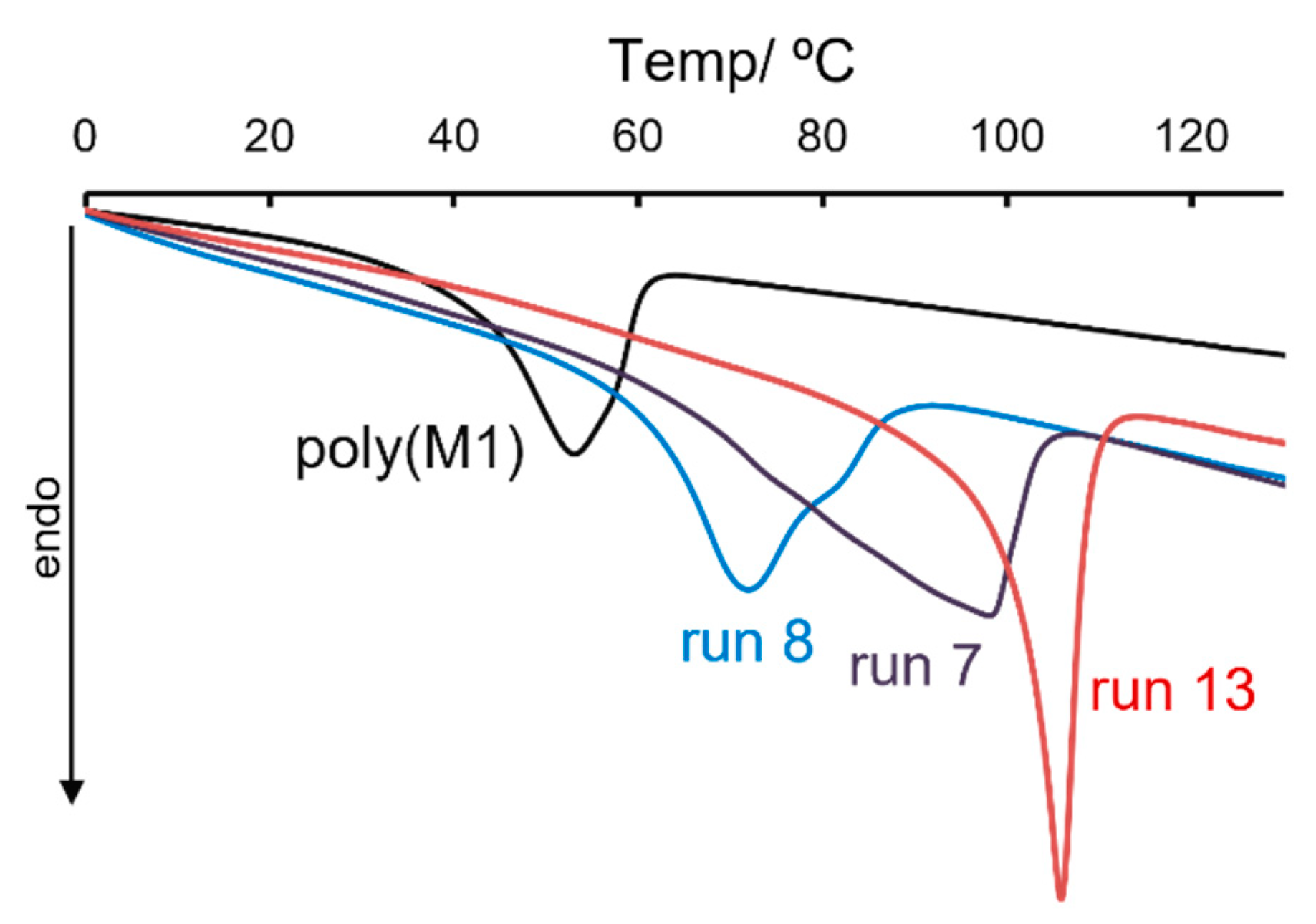
| Run | ADMET Polymerization | Hydrogenation | ||||||||
|---|---|---|---|---|---|---|---|---|---|---|
| DCD | Cat. | No. Solvent Exchange b | Yield c | Time | Mn d | Mw/Mn d | H2 | Time | Tm e | |
| /mmol | /mol% | /% | /h | /MPa | /h | /°C | ||||
| 1 | 3.25 | 1.0 | 0 | 80.0 | 6 | 7000 | 1.46 | 1.0 | 24 | 100.9 |
| 2 | 3.25 | 1.0 | 0 | 65.5 | 24 | 9300 | 1.78 | 1.0 | 24 | 104.5 |
| 3 | 3.25 | 1.0 | 0 | 82.7 | 48 | 10,600 | 1.56 | 1.0 | 24 | |
| 4 | 3.25 | 2.0 | 0 | 70.9 | 24 | 5000 | 1.53 | 1.0 | 24 | 104.0 |
| 5 | 3.25 | 0.50 | 0 | 71.3 | 24 | 3100 | 1.47 | 1.0 | 24 | 103.4 |
| 6 | 3.25 | 0.25 | 0 | 52.1 | 24 | 3500 | 1.45 | 1.0 | 24 | 103.3 |
| 7 | 1.63 | 1.0 | 0 | 76.0 | 24 | 7300 | 1.66 | 1.0 | 24 | 98.2 |
| 8 | 0.65 | 1.0 | 0 | 72.2 | 24 | 9600 | 1.67 | 1.0 | 24 | 71.7 |
| 9 | 3.25 | 1.0 | 1 | 87.0 | 24 | 12,600 | 1.77 | 1.0 | 3 | 107.6 |
| 9-2 f | 2.0 | 3 | 105.1 | |||||||
| 10 | 3.25 | 1.0 | 1 | 90.5 | 24 | 9800 | 1.61 | 1.0 | 6 | 105.9 |
| 10-2 f | 1.0 | 24 | 106.8 | |||||||
| 11 | 3.25 | 1.0 | 1 | 70.1 | 24 | 9500 | 1.64 | 1.0 | 3 | 104.9 |
| 11-2 f | 2.0 | 24 | 105.7 | |||||||
| 12 | 3.25 | 1.0 | 1 | 88.2 | 24 | 11,400 | 1.68 | 1.0 | 24 | 106.6 |
| 13 | 3.25 | 1.0 | 4 | 72.1 | 24 | 19,200 | 1.66 | 1.0 | 24 | 105.5 |
| 14 | 3.25 | 1.0 | 6 | 85.6 | 24 | 23,400 | 1.48 | 1.0 | 4 | 106.8 |
| Run | Cat. | No. Solvent Exchange b | Yield c | Mn d | Mw/Mn d | Tm e |
|---|---|---|---|---|---|---|
| /mol% | /% | /°C | ||||
| 15 | 1.0 | 1 | 80.2 | 4400 | 1.58 | 106.5 |
| 16 | 1.0 | 2 | 72.1 | 6700 | 1.67 | 105.2 |
| 17 | 1.0 | 4 | 84.1 | 6400 | 1.61 | 107.8 |
| 18 | 0.50 | 2 | 83.5 | 6100 | 1.61 | 107.0 |
| 19 f | 0.50 | 4 | 82.8 | 6700 | 1.56 | 107.0 |
Publisher’s Note: MDPI stays neutral with regard to jurisdictional claims in published maps and institutional affiliations. |
© 2021 by the authors. Licensee MDPI, Basel, Switzerland. This article is an open access article distributed under the terms and conditions of the Creative Commons Attribution (CC BY) license (https://creativecommons.org/licenses/by/4.0/).
Share and Cite
Kojima, M.; Abdellatif, M.M.; Nomura, K. Synthesis of Semicrystalline Long Chain Aliphatic Polyesters by ADMET Copolymerization of Dianhydro-D-glucityl bis(undec-10-enoate) with 1,9-Decadiene and Tandem Hydrogenation. Catalysts 2021, 11, 1098. https://doi.org/10.3390/catal11091098
Kojima M, Abdellatif MM, Nomura K. Synthesis of Semicrystalline Long Chain Aliphatic Polyesters by ADMET Copolymerization of Dianhydro-D-glucityl bis(undec-10-enoate) with 1,9-Decadiene and Tandem Hydrogenation. Catalysts. 2021; 11(9):1098. https://doi.org/10.3390/catal11091098
Chicago/Turabian StyleKojima, Mika, Mohamed Mehawed Abdellatif, and Kotohiro Nomura. 2021. "Synthesis of Semicrystalline Long Chain Aliphatic Polyesters by ADMET Copolymerization of Dianhydro-D-glucityl bis(undec-10-enoate) with 1,9-Decadiene and Tandem Hydrogenation" Catalysts 11, no. 9: 1098. https://doi.org/10.3390/catal11091098
APA StyleKojima, M., Abdellatif, M. M., & Nomura, K. (2021). Synthesis of Semicrystalline Long Chain Aliphatic Polyesters by ADMET Copolymerization of Dianhydro-D-glucityl bis(undec-10-enoate) with 1,9-Decadiene and Tandem Hydrogenation. Catalysts, 11(9), 1098. https://doi.org/10.3390/catal11091098







